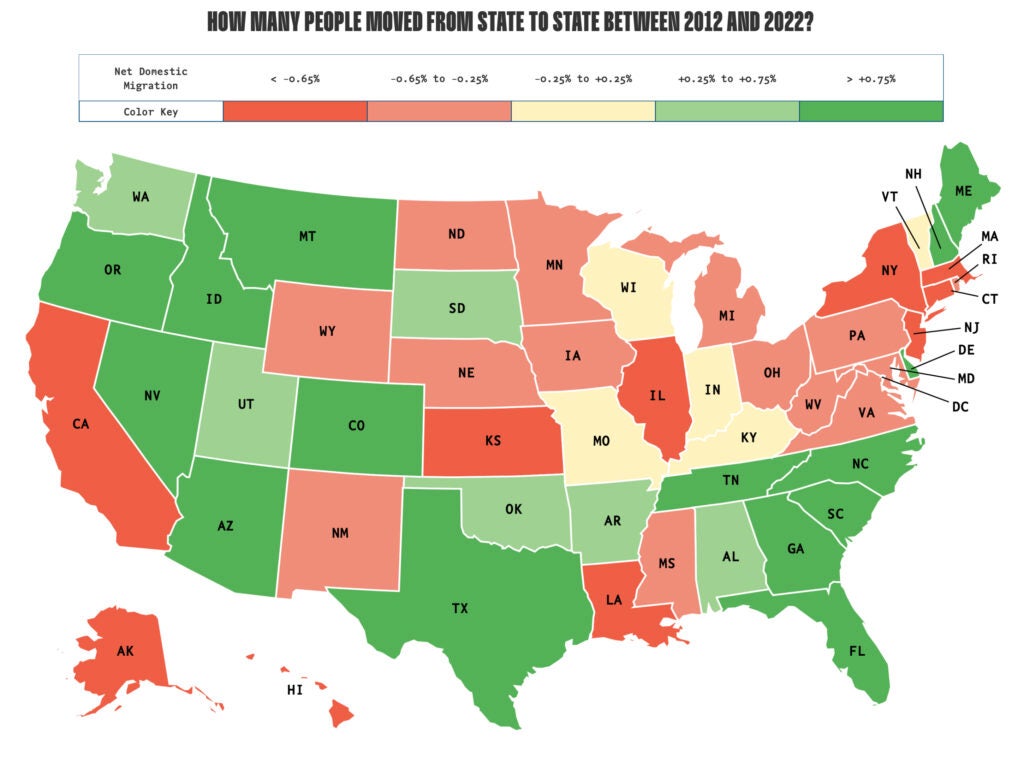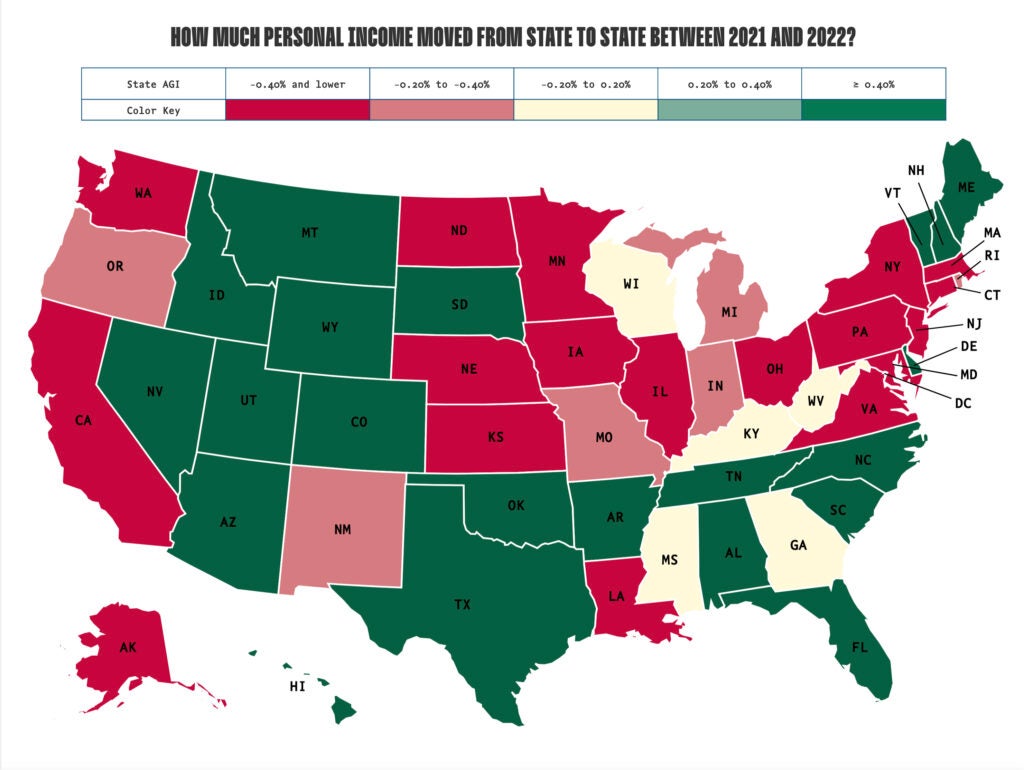Migration to Red States Is Accelerating, Study Says

America’s economic engine is moving south, according to a newly released analysis of IRS and census data by an organization called Unleash Prosperity.
Live Your Best Retirement
Fun • Funds • Fitness • Freedom
“The single most important thing that is going on in this country, economically and demographically, is the massive shift in migration that’s happened over the last 10 to 20 years, and it is accelerating,” economist Steve Moore told attendees at the launch of Unleash Prosperity’s interactive migration website called votewithyourfeet.net.
For the previous two centuries, America’s northeastern states were the dominant region for economic production and growth, Moore said.
“You think of New York and Philadelphia and Baltimore and New Jersey, and that area was the apex of American economic and financial power, but that is no longer the case,” he said. “For the first time in history, the southeast is now the dominant region of the country in terms of production.”
Based on IRS tax reporting from 2012 to 2022 and data from the U.S. Census Bureau, Unleash Prosperity’s site shows which states people are fleeing, and which states they are calling their new home. New York and California top the list of exodus states, having lost 1.7 million and 1.6 million people, respectively, over this decade. Illinois, New Jersey, Massachusetts, Pennsylvania, Maryland, Louisiana, Virginia, and Connecticut round out the top 10 for negative migration.
The top states gaining population are Florida (1.6 million) and Texas (1.3 million), followed by North Carolina, Arizona, South Carolina, Tennessee, Georgia, Nevada, Washington, and Idaho. The founders of Unleash Prosperity include Moore, economist Arthur Laffer, and publishing magnate Steve Forbes.
Migration within America generally follows political lines, with red states gaining population and blue states losing, according to Unleash Prosperity data. Even with blue states that gained population, the migration is largely coming from other blue states. For example, Washington state experienced 217,304 net positive migration, but more than half that surplus, 146,280, came from California.

Virginia Gov. Glenn Youngkin, also speaking at the launch event, attributed the population shift to what he called a virtuous cycle in red states of cutting or eliminating state income taxes, which led to a greater influx of people and jobs, which created a larger tax base and more revenue for state budgets.
“Those people are going to bring with them their income, and they’re going to pay taxes, and then we have a surplus, and with that surplus we get to invest in education and law enforcement and behavioral health, and we get to reduce taxes again,” Youngkin said. “This virtuous cycle actually works, and we know it works because that is what we’ve unleashed in the Commonwealth of Virginia.”
Between 2012 and 2022, Virginia experienced a net outflow of people every year, but this was reversed in 2023 following a reduction in state income tax rates, Youngkin said. “In 2023 for the very first time, Virginia broke the mold, and we were number nine in the nation for net in-migration, coming from number 40 the year before.”
States that have no income tax at all include Alaska, Florida, Nevada, New Hampshire, South Dakota, Tennessee, Texas, and Wyoming.
The Unleash Prosperity migration analysis also tracks the money moving from high-tax to low-tax states. The 10 states with the highest income taxes have lost more than $200 billion of income to low-tax states, according to the organization.

California, for example, lost more than 360,000 people to Texas, and transferred nearly $21 billion in income between 2012 to 2022, Unleash Prosperity data indicates. New York lost more than 380,000 people and $37 billion in income to Florida.
In line with the Unleash Prosperity study, a 2024 report by the Institute for Family Studies stated that red states are increasingly attractive for families with children. Despite Minnesota Democrat Gov. Tim Walz being hailed by left-wing pundits for his “family-friendly” policies, more families left his state than moved into it, authors Brad Wilcox and Lyman Stone, senior institute fellows, wrote.
Minnesota ranked in the worst third for negative family migration, measured as a percentage of population, together with New York, Alaska, California, Oregon, Washington, Massachusetts, and Illinois. Measured in terms of the sheer number of families moving out, California led the pack with 92,000.
“Blue states that voted for Democratic presidential candidates in both 2016 and 2020 lost 213,000 families with children in 2021 and 2022 (a 0.7% net decline), while red states that voted for President Donald Trump in both elections gained 181,000 families (a 0.6% net gain),” Stone and Wilcox stated. States that saw the largest number of families moving in were Texas (53,000), Florida (38,000), Georgia (22,000), Arizona (16,000), South Carolina (15,000), and Tennessee (13,000).
The migration to red states will also likely lead to a loss of votes in the Electoral College for blue states that have lost population, as well as a loss of congressional seats. But there remains the question of whether migration from blue states will ultimately turn red states purple like Georgia, which Joe Biden won in the 2020 presidential election.
We publish a variety of perspectives. Nothing written here is to be construed as representing the views of The Daily Signal.
The post Migration to Red States Is Accelerating, Study Says appeared first on The Daily Signal.
Originally Published at Daily Wire, Daily Signal, or The Blaze
What's Your Reaction?
 Like
0
Like
0
 Dislike
0
Dislike
0
 Love
0
Love
0
 Funny
0
Funny
0
 Angry
0
Angry
0
 Sad
0
Sad
0
 Wow
0
Wow
0









































































